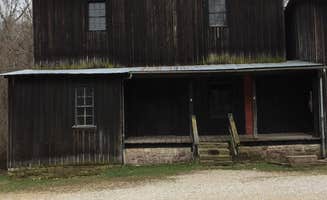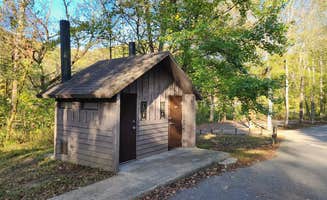Glamping near Houston, Missouri centers around the spring-fed Current and Jack's Fork Rivers in the Missouri Ozarks. At elevations of 900-1,500 feet, these waterways carve through limestone terrain creating cold, clear streams ideal for trout fishing and summer recreation. Winter temperatures can drop below freezing, while summer days reach the upper 80s with humidity making riverside camping a cooling respite.
What to do
Trout fishing at specific access points: Round Spring Campground offers excellent fishing spots where the Current River provides ideal conditions. "This is a popular campground for canoeing on the Current River, also fishing and hiking. There is also a small cavern with ranger tours," notes Joel R.
Cave exploration with lantern tours: Take guided tours of Round Spring Cave from June through August for $5. "The lantern tours show an amazing cave with many beautiful formations," says Marty C. These tours offer a cool underground escape during hot summer days.
Hiking the Ozark Trail: Access portions of the Ozark Trail system from multiple camping locations. One camper explains, "If you walk to the spring overlook, you'll also encounter a portion of the Ozark Trail. About a half a mile down the Ozark Trail you can cross the Current River on a pedestrian bridge which is a pretty cool experience."
Swimming at natural pools: Visit natural swimming areas at Harveys Circle B Campground where the Jack's Fork River provides safe wading areas. "A beautiful riverfront campground on the Jack's Fork River," notes Ken K., making it perfect for cooling off during summer months.
What campers like
Spring viewing opportunities: Lane Spring Recreation Area offers peaceful creek settings with abundant wildflowers in spring. "I stayed the night here in late April, and it was absolutely gorgeous. The campground is in the middle of a forest with a large creek running around it... there were wildflowers popping up all over the place," shares Erin.
Wildlife viewing: Many campgrounds offer opportunities to spot native wildlife including otters, wild horses, and bald eagles. "We saw a bald eagle and a very curious little otter down by the river," reports Theresa H. about Round Spring Campground.
Ranger-led educational programs: National Park Service campgrounds feature interpretive programs. "The host was great did a nice show at the amphitheater about the local area," writes Jeff A. These programs typically run May through September.
Off-season tranquility: Visiting during spring or fall offers more solitude. "We spent 3 week days camping here in our camper van. When we were there in April there were only a handful of other campers there and we tons of quiet and privacy, however, I imagine during the summer it fills up," notes Theresa H.
What you should know
Reservation requirements: Popular sites fill quickly, especially at Echo Bluff State Park. "The only negative is that we have experienced are that you need to reserve your side months in advance because this campground is so popular," explains J K. Most campgrounds accept reservations 6 months in advance.
Cell service limitations: Many camping areas have little to no cell coverage. "There is zero cell service but you can drive about 2 miles up the road to the state park and connect their WiFi," shares Stephanie N.
Wildlife precautions: Be prepared for wildlife encounters including snakes. "Keep an eye out for copperheads and water moccasins along with black widow spiders. The gnats can get pretty bad in the evenings but quickly go away once the sun sets."
Flooding potential: Some areas experience seasonal flooding. "There was some really bad flooding a few years ago that caused some significant damage in the area that closed campground as well as some others along the river." Check conditions before visiting spring through early summer.
Tips for camping with families
Kid-friendly ranger programs: Pulltite Campground offers family-oriented activities. "Nightly fun activities, close to many different hiking trails, and an on-site general store," mentions Shona H., making it ideal for families with children.
Safety around water: Rivers and streams require supervision. "This is not a place for the kids to run wild. Keep an eye out for copperheads and water moccasins along with black widow spiders."
Secure food from wildlife: Take precautions with food storage. "The raccoons and armadillos can be a bit rowdy and too close for comfort some nights, so secure your food carefully. Also, in recent years, black bear sightings are becoming more frequent."
Short hikes for young explorers: Look for beginner-friendly trails. "Hike the quarter mile trial to the springs (one of my son's favorites, he likes to search for the water bubbling out of the ground)." These shorter trails are manageable for children while still providing natural discovery opportunities.
Tips from RVers
Site selection for shade: At Montauk State Park Campground, select sites carefully for comfort. "Very nice campground, tons of shade! My site (206) was very level and was surrounded in trees like basically ever other site which made it comfortable to sit outside all day," says Trevor S.
Utility hookups vary: RV sites offer different amenities across campgrounds. "There is water and eclectic with a dump station. Shower house is old needs to be updated. Toliets were clean. Showers aren't in the best shape," notes Mike B. at Jason Place Campground.
Site levelness considerations: Many campgrounds have varying terrain. "Sites are not that private, but nice and level and grassy with the usual fire ring and picnic table. Some sites had trees for hammocks and some, not so much."
Limited big rig access: Several campgrounds have restrictions for larger RVs. "Paved throughout. Plenty of clean restrooms and showers. Nice, basic and electric sites. Riverfront sites also. Some group sites there also."




